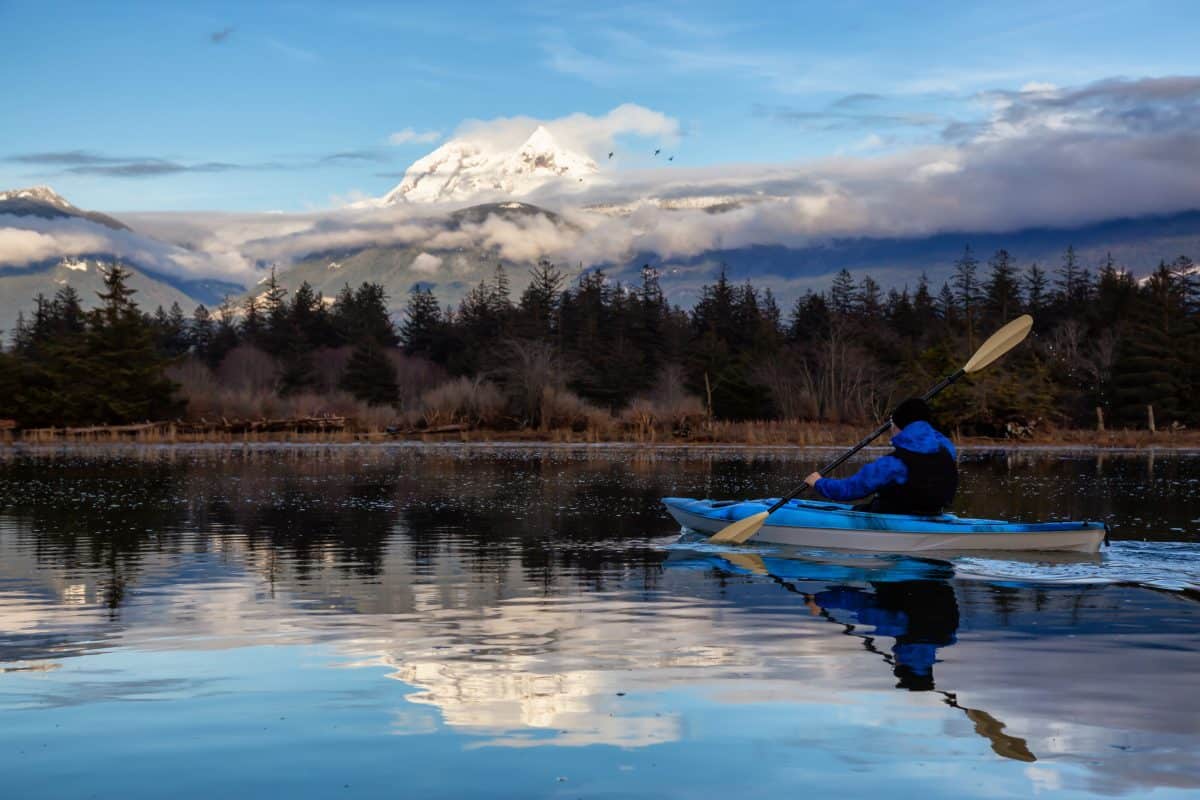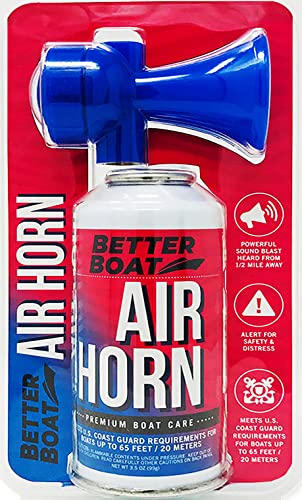Kayaking doesn’t seem like the type of activity that would have a dress code. Still, what you wear does make a difference and, to make matters more complicated, depends on the environment you’ll be paddling in, too.
The golden rule regarding what to wear kayaking is simple:
Dress for the water temperature – not the weather.
Does that mean regular beachwear should do?
Quite the contrary.
Sure, weather conditions are something to keep in mind, but you shouldn’t choose your outfit based on air temperature alone. Kayakers dress for getting wet; simple as that.
Keep reading for a more detailed explanation on what to wear for a day on the water!
We may receive a commission if you click a link on this page and then go on to purchase something, but at no extra cost to you. Learn more here.
General Clothing Recommendations & Tips For Kayakers

You wouldn’t go hiking in your office attire nor skiing in your workout clothes. Why should kayaking be any different than other types of outdoor activities?
As you prepare for your next paddling session, keep these general guidelines for what to wear kayaking in mind:
- Check the Weather Forecast – Remember to check the forecast when planning your kayaking trip; it’s easier to prepare when you know what to expect. Keep extra layers on hand if the weather seems iffy and cold conditions loom.
- Pack Spare Clothes – You’ll probably be drenched by the time you wrap up your paddling session. Pack a towel and a change of clothes and keep everything stored in a watertight bag. Dry clothes make the trip home a lot more comfortable.
- Dress for Immersion – Assume that you will capsize and prepare for it. Otherwise, you risk going into cold shock and hypothermia. The “kayakers dress for the water, not the weather” rule exists for a reason.
- Consider the Where and How – A quick paddle on a nearby pond won’t call for the same outfit as conquering class IV whitewater rapids; that’s all I’m saying.
- Layers, Layers, Layers – Several thinner layers, consisting of synthetic materials, are a better choice than a single, thick one. The clothes will dry faster, and you’ll be able to shed a layer or two if things get hot.
- Aim for Comfort and Freedom of Movement – Comfort isn’t something to be overlooked. Opt for clothes that won’t be too tight or restrict your movement; you want to swing the paddle as freely as possible.
- Don’t Forget Sun Protection – A day of kayaking is a day of direct sun exposure. Besides sunscreen, consider wearing UV-protective clothes made of UPF-rated fabrics, preferably long-sleeved for better coverage.
- Stay Hydrated and Bring Snacks – You’ll need to keep your energy levels up and watch your hydration throughout the day. So, pack carbohydrate-rich snacks and water bottles, especially for longer paddling sessions.
A Quick Word On Clothing Materials & Why You Should Avoid Cotton
If you were in a desert, then sure, cotton will be more than welcome – but on the water?
Cotton kills.
That may sound overly dramatic, but here’s the thing about cotton:
- It takes forever to dry
- It provides no insulation when wet, causing you to lose body heat at a rapid rate
- It absorbs water, insane amounts, causing discomfort and making it harder to swim
- It doesn’t have moisture-wicking properties
Cotton is hands down, the worst choice of clothing material for a kayaker – and should never be worn on the water, period.
What should you wear for kayaking, then?
Quick-drying, insulating, and moisture-wicking synthetic fabrics – think neoprene, polyester, nylon, and polypropylene – are your safest bet in a wet and cold environment.
If you’re set on going with natural fibers, then I strongly recommend Merino wool. It might not “perform” as well as synthetics when wet, but it still beats cotton.
What To Wear Kayaking In Summer

You feel the sun on your skin, the air is warm, and the warm water is inviting; nothing beats a summer afternoon on the water.
Figuring out how to dress for kayaking shouldn’t be hard, either. I mean, as long as it’s comfortable and light, keeps you cool and protects you from the sun, I’d say you’re good.
I do have some suggestions on what to wear kayaking in warm weather, though:
- Long-Sleeve Shirt – It might seem counterintuitive, but a loose-fitting, long-sleeved T-shirt made of fast-drying fabrics with polyester webbing can keep you cool and prevent overheating. Another advantage of long-sleeve shirts for paddlers – rash guards being the perfect example – is better coverage and, in turn, a lower risk of sunburn.
- Shorts – As long as it’s quick-to-dry, comfortable, and doesn’t restrict your movement or cause chafing, you can wear pretty much any shorts you’ve got – except jeans, of course. Be sure to avoid super-thin fabrics, as they likely won’t survive the constant friction and harsh environments for long. If you prefer a longer legged bottoms then a set of yoga pants are a great option.
- Water Shoes or Sandals – Water shoes, sandals with heel straps, or going barefoot if the conditions allow it – whatever you find comfortable. Avoid flip-flops, though. They might fit the beach vibe, but they slip off easily – and at the most inconvenient times – and offer minimal protection. Always protect your feet!
- Wide-brimmed Hat – A wide-brimmed hat is an additional layer of defense against the UV rays for your face, head, and shoulders. Remember to use a chin strap or a cap leash to secure your hat, or it might get blown away with the first gust of wind.
- Sunglasses – Prolonged exposure to reflected UV radiation can damage your eyes and lead to photokeratitis, a condition similar to “snow blindness.” Sunglasses with polarized lenses provide additional eye protection in high-glare conditions. Consider using eyewear retainer straps, so you don’t lose them in the water.
- Sunscreen – While sunscreen alone isn’t enough, it’s an essential part of your sun protection strategy. Water-resistant sunscreen, with an SPF rating of 30 to 50, is your best bet. Don’t be fooled by cloud cover on a warm day, apply it liberally – seriously, go crazy – and make sure you reapply it every 40 to 80 minutes.
What To Wear When Kayaking In Winter & Cold Weather

First and foremost, paddling in winter and cold weather isn’t for everyone – and I’m not even talking about the evident lack of comfort and coziness. Hypothermia, cold shock, and drowning; the risks are real and downright fatal.
I need you to remember that before you ever consider hitting the waters in the middle of winter.
You’ll have both the weather and the water working against you. And in such conditions, your choice of kayaking outfit could – quite literally – save your life.
With that in mind, here are some suggestions on what to wear for kayaking in cold winter weather:
- Paddling Jacket – Cold and wet isn’t most peoples idea of fun, but lets face it kayaking in the winter these are both occupational hazards. So, invest in a rain jacket with a fleece lining or a drytop. A dry-top will keep the water out but it wont keep you warn – so you will need to wear a thermal base and mid layer underneath it.
- Layered Long-Sleeve Tops – No one likes feeling cold so a base-layer and thermals made of quick-drying synthetic materials are your first line of defense. They trap warm air against your skin, wick away sweat, and help regulate body temperature. A form-fitting rash guard, topped with a warm mid fleece layer, is a safe bet. However, base layers won’t mean much without a waterproof windbreaker jacket as your outer layer or “shell.”
- Bottoms – If it’s a bit chilly outside, a long pair of so-called splash pants designed specifically for paddling should be enough to keep you warm. But if we’re talking about a significant drop in temperature, you might want to consider long underwear as your base layer. That way, you’ll achieve the right balance of heat retention and moisture-wicking.
- Hat – Adding a hat – a beanie, for example – to your winter kayaking outfit should be enough to keep you warm. However, if you’re hitting the water in extremely low temperatures, a balaclava-type hat that covers your entire head, including face and neck, will be a much smarter choice.
- Gloves – “Regular” gloves won’t do; you’ll have to get yourself a pair of neoprene gloves if you want to prevent your hands from feeling like two blocks of ice. If that doesn’t cut it, go with pogies. These thermal paddle mitts attach to the paddle and, combined with neoprene gloves, can further protect your hands in extreme cold.
- Footwear – I have two words for you – neoprene boots. These waterproof shoes will do wonders for keeping your feet warm and dry in colder weather while also protecting your toes and the soles of your feet in harsh environments. You can always pair them with waterproof or thermal socks for added warmth.
When To Wear A Wetsuit Or A Dry Suit – And What’s The Difference?
If temperatures fall below 60 degrees Fahrenheit, you’ll have to pull out the big guns. The same goes for a combined air and water temperature of under 120 degrees Fahrenheit.
And by “big guns,” I mean specialized full-body suits for watersports designed to ensure thermal insulation in the cold, winter air and water temperature – .
You have two options – wetsuits and drysuits – and which one you choose depends on the severity of the weather conditions:
Wetsuits
Wetsuit, are typically made of thick neoprene, aren’t waterproof and are considered the “bare minimum” in temperatures below 60 degrees Fahrenheit.
Although skin-tight, they allow some water to get in and fill the space between your skin and the suit’s inner layer, meaning you still get wet. However, this thin layer of water, warmed by your body’s temperature, acts as insulation, slowing down heat loss.
The thermal protection of a wetsuit can be further increased with the use of a neoprene hood, gloves, and boots – some people will also wear undergarments, as more layers generally equal more insulation.
Make sure you check out my roundup of the best wetsuits for kayaking for some great wetsuit recommendations!
Drysuits
Loosely-fitting dry suits will be your ultimate weapon against cold water and freezing temperatures
They’re made of waterproof materials and feature watertight zippers and cuffs on all openings – around the ankles, wrists, and the neck. They keep the water out and the inside of the suit dry, hence the name – dry suit!
However, a dry suit isn’t capable of keeping you warm on its own and preventing the dreaded hypothermia; it’s the thermal base layers you wear underneath that count, such as a fleece jacket and thermal underwear.
For more great recommendations check out my roundup review of the best drysuits for kayaking.
Safety Equipment Is Mandatory – No Matter The Weather

It shouldn’t matter if the water is warm or freezing or what the weather is like; the importance of safety equipment is one thing that never changes.
So, as you go over your equipment checklist, be sure to include the following safety gear:
- Personal Flotation Device (PFD) – A USCG-approved Type III PFD is the single most crucial thing you’ll wear for kayaking. The layers underneath may change, but you should always have your life jacket on – no exceptions – wear a life jacket at all times!.
- Helmet – A hat protects you from the elements, but a helmet protects your brain. If there’s even a slight chance of hitting your head – in choppy waters, rapids, and rocky environments – you need one.
- Gloves – Paddling gloves are an excellent accessory that every kayaker should have on hand – pun intended – as they protect against cuts, blisters, and frostbite. Plus, they allow for a better grip on the paddle.
- Spray Skirt – This one technically doesn’t count as clothing, but it’s worth adding a spray skirt to your outfit if you have a sit-inside kayak, and especially if whitewater kayaking. Not only does it keep water out but traps warm air in, as well.
Kayaking At Night Requires Additional Gear
Besides the drop in temperature, kayaking at night is a different kayaking adventure and experience. Night kayaking mean you also have to account for the lack of visibility in low-light conditions and pack:
- Reflective tape for the life jacket’s front, back, and straps, on the backside of the paddle blades, and the kayak’s bow and stern.
- Sound-producing devices for reduced visibility conditions, like a dual-tone whistle or an air horn.
- Visual distress signals (VDS) required by the USCG, such as handheld or aerial red pyrotechnic flares. – and is especially important if you are sea kayaking.
What To Wear For Kayaking – Frequently Asked Questions
Can you kayak barefoot?
If the weather is nice, the water is warm, and you’re comfortable ditching your socks and sandals, then yes, you can kayak barefoot. Nothing prevents you from doing so – and it sure beats wearing the wrong kind of shoes.
At least you won’t have to worry about your socks getting drenched, huh?
Do you get wet kayaking?
You’re on the water, your paddle is splashing left and right, there might be waves hitting your kayak, and you could get caught in the rain. If circumstances conspire against you, you might even flip your kayak over, too.
I’d say your chances of getting wet are pretty high. That’s the whole point of the kayaking dress code, in case you haven’t been paying attention.
What shoes do you wear kayaking?
Neoprene paddling booties ensure that water stays out and warmth stays in, making them perfect for kayaking in colder weather, especially when paired with thick socks for added insulation.
As for warmer weather, opt for fast-drying water shoes or sandals with chunky rubber soles and back straps.
Should you wear a bathing suit kayaking?
I have one word for you – chaffing. A bathing suit seems like a good idea, but wait until you get on the water and your bare skin starts rubbing against the PFD with every paddle stroke. I can pretty much guarantee that you’ll regret your outfit choice ten minutes into your kayaking trip.
Can you wear sneakers for kayaking?
Nope, old sneakers won’t do. For starters, they’re not designed to come in direct contact with water, and the not-so-stellar traction could spell trouble on the kayak’s wet deck.
Moreover, sneakers don’t drain particularly well. It’s going to feel like you have two bricks tied to your feet, which is not only uncomfortable as heck but hard to swim in, too. Also, wet sneakers tend to smell – bad.
Summing It Up
When it comes to what to wear kayaking, one word you should keep in mind is “practicality.” I’m afraid functionality beats style this time around.
You want clothes that can keep you cool when it’s hot, warm when it’s cold, and, most importantly, dry when it’s wet. Moreover, you want something breathable, quick-drying, comfortable to move in, and durable.
Oh, and I hope I’m not asking too much, but try to keep things as light as possible. You’re not exactly working with unlimited space on a kayak.
That said, remember:
When in doubt, pack it in a dry bag and bring it with you.
Before setting off, always check the weather and water temperatures. It’s better to pack something extra and end up not needing it than to head out and find yourself in a situation where you wish you had it.




















